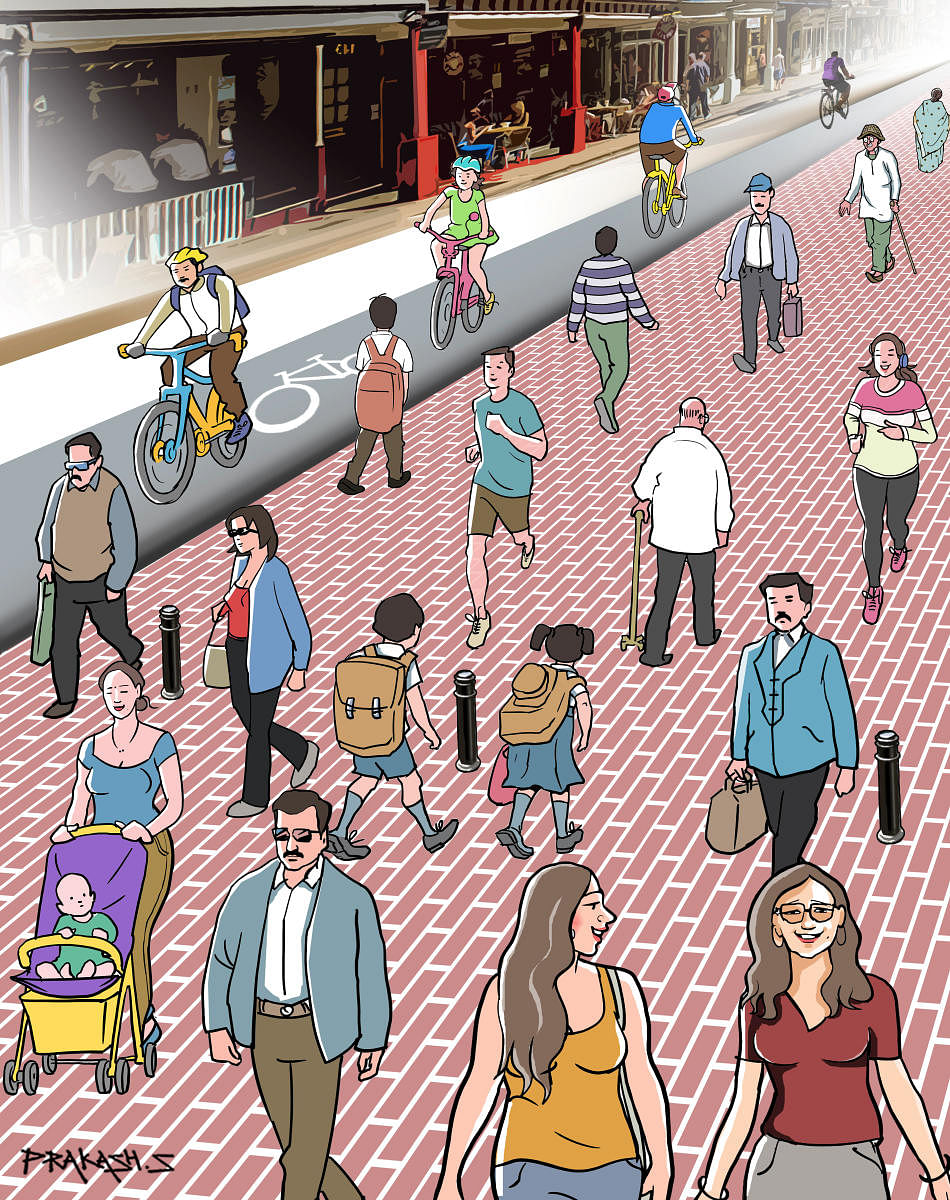
Walking was once a super cool breeze in Bengaluru. But that paradise for pedestrians was lost long ago, crushed under the onslaught of a motorist-focused mobility policy. Can a belated attempt to pedestrianise three key inner-city streets reverse the damage?
The recent State Budget articulated a plan to turn Brigade Road and Commercial Street into pedestrian-only zones. Walkers, pushed dangerously to the periphery for decades, applauded in collective delight. But then came the traders, crying foul.
Traders apprehensive
Their fear that total pedestrianisation would spell doom for business had a basis: A perceived drop in business on Church Street after a pedestrian-first upgrade. Modeled on TenderSURE roads, the Rs 15 crore upgrade of that street stopped short of a total ban on vehicular movement.
All set to petition the Chief Minister H D Kumaraswamy and his Deputy G Parameshwara, the traders have a clear demand: Forget total pedestrianisation without first building multi-level parking facilities near Brigade Road and Commercial Street.
Their rationale: Most customers prefer to drive their cars right up to the shops. Banning vehicles will discourage them, forcing them to shift to malls. But buyers may not go away if parking complexes are built within walking distance.
Metro allays fears
Sustainable mobility activists agree that parking lots are required. But they are not convinced that the need to walk will keep customers away. “Traders think business happens only when buyers come in cars. With the Metro coming in, those fears can be allayed,” reasons Sathya Sankaran from Citizens for Sustainability.
Even in malls, people walk a lot across multiple levels. “Assume vehicles moving through all the floors of a mall. Will customers prefer that? Traders should rethink their methods if they want to attract new customers. The main streets need to compete with malls,” he elaborates.
Shuttle buses can take people from the Metro station and parking lots. But the Metro, says Sankaran, should allow people to carry the shopping luggage and not have high restrictions. As for parking complexes, he wonders what happened to the underground facility promised under the Parade Grounds.
Do test run first
Pedestrianisation should not imply pedestrian-only, reminds urban architect Naresh Narasimhan, who designed the Church Street upgrade. “Pedestrianisation means priority for pedestrians. I had suggested to first try out vehicle bans during weekends. Have a public consultation involving all stake-holders. Study weekend bans for a month and analyse the data,” he explains.
Every street will require a different approach. For instance, a test run will show how many business outlets have car parking facilities on a particular road. On Brigade Road, Narasimhan suggests, the carriageway could be reduced to two lanes with a lay-by and the footpaths widened.
Model to emulate
The larger objective of a pedestrian-first approach to roads is this: A network of such roads in the CBD area acting as a model to emulate in the rest of the city. Vast swathes of Bengaluru have roads with footpaths in dire straits. They are either encroached upon by business interests and motorcyclists or are in dangerously poor shape with shaky slabs. Most stretches are poorly lit, making it extremely risky to walk.
Pedestrians, the elderly and the disabled in particular, struggle to walk, as widened roads have narrowed down footpaths. Crossing at grade is a nightmare and signal-jumping motorists have made signaled intersections too dangerous. Skywalks across the city remained virtually unused.
BBMP plans
The Bruhat Bengaluru Mahanagara Palike (BBMP) has been tasked with redeveloping the roads in the Central Business District (CBD). “Both the shopping hubs will be redeveloped under the Smart Cities Mission. A total of 20 roads will be redeveloped in a similar manner at a cost of Rs 200 crore,” informs a Palike official.
The pedestrianisation move is not restricted to the CBD area. BBMP Commissioner, N Manjunath Prasad elaborates, “By upgrading footpaths across the city, we are giving priority to the pedestrians. Last year, the BBMP had kept aside around Rs 200 crores exclusively to redevelop the footpaths.”
The footpaths will be upgraded under the TenderSURE project. “We are also widening the pavements. The civic body will focus on the high-density corridors or major roads of the city to make them pedestrian-friendly in coming days,” Prasad explains.
Footpath upgrades
In December 2018, the Palike had taken up a drive focused on lane markings, kerb paintings, fixing broken/missing tiles on footpaths, proper functioning of streetlights, regular sweeping of roads, use of mechanical sweeping machines, beautification of junctions and medians.
The focus is also on restoration of missing grills, pruning of trees and removal of illegal OFC cables on high-density corridors.
But can footpath upgrade and a pedestrian-focused approach work without giving a well-planned, parallel boost to public transport, last-mile connectivity and traffic management? A network of upgraded, pedestrianised roads in the CBD area could give the idea a boost. To truly transform the walkers’ path, the idea requires a city-wide replication. And, there lies the challenge.